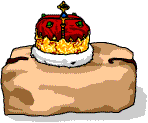The Stone of Destiny
Created | Updated Mar 26, 2009

The Stone of Destiny is the stone that Queen Elizabeth II of England and I of Scots was crowned upon1. The history of this stone is a long one and there is much discussion as to whether or not it is the real stone.
Ancient History
The legend of the Stone of Destiny begins in biblical Palestine. It is the stone that Jacob is said to have used as a pillow as he slept at Bethel, when he dreamed of angels ascending a ladder to Heaven.
This stone then made its way to Egypt, eventually coming into the possession of the pharaohs. One of the pharaohs had a daughter, Scota, who travelled to the British Isles with the stone and founded the Scottish race in Ireland.
This stone became known as the Lia Fail and it was believed that to become King of the Scots, one had to be crowned while sitting upon it. Also, wherever the stone went, the Scots would follow.
Hence they took it with them to modern Scotland when they moved from Ireland. From then on, all Kings of the Scots were crowned sitting on this stone, which was kept at Scone2, in Fife. Hence it is sometimes referred to as the 'Stone of Scone'.
More Recent History
In 1296, Edward I of England invaded Scotland. To prove that Scotland was no more, he took all artefacts that symbolised it as an independent nation south to London. This included the royal crown, the Seal of Scotland, the Holy Rood3, and all the documents that could show that Scotland had ever existed as a separate nation. Edward also took the Stone of Destiny.
In 1603, James VI of Scots became James I of England and Ireland, after Elizabeth I of England and Ireland died childless. Thus he moved to London to claim his throne and, incidentally, to sit upon the Stone of Destiny, proving the old prophecy that the Scots would follow the Stone.
In 1950, a group of Scots students broke into Westminster Abbey in London and stole the stone. They took it on a merry little tour of Scotland, through people's sheds and pub cellars before eventually leaving it in the ruins of Arbroath Abbey4 for the police to find.
Finally, in 1996, the then Conservative government returned the stone to Scotland and it is now kept in Edinburgh Castle which is on the Royal Mile. They had hoped to improve their standing in the following general election, but they actually lost all their seats in Scotland, which obviously says something.
Not Proven
There are a number of theories which claim that the stone now on display in Edinburgh Castle is not the original stone. These include claims:
That the students returned a fake stone.
That the real stone was spirited away before Edward I of England could get at it.
That Edward took a fake stone, either one from the walls of Scone, or perhaps even a cesspit lid.
That, after the Treaty of Northampton in 1328, the English returned everything they took, except the stone, as the Scots had not asked for it back, presumably as it was a fake.
There are also ancient Celtic tales which claim that the stone is one of four magical items, including a spear5, a sword and a cauldron6, that the True King of Ireland would use to rule.
All that can be truly said of the stone is that it is a lump of stone, it lies in Edinburgh and it is not that much of a vote winner.

